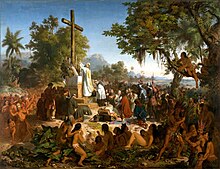Portuguese Brazilians
Although present since the onset of the colonization, Portuguese people began migrating to Brazil in larger numbers and without state support in the 18th century.[4] During the 17th century, most Portuguese settlers in Brazil, who throughout the entire colonial period tended to originate from Northern Portugal,[5] moved to the northeastern part of the country to establish the first sugar plantations.Some of the new arrivals were New Christians, that is, descendants of Portuguese Jews who had been induced to convert to Catholicism and remained in Portugal, yet were often targeted by the Inquisition (established in 1536) under the accusation of being crypto-Jews.[7] In 1751 Macapá in Amapá received Azoreans and it was recommended to the captain of the ship to have a special care with the settlers, since "for the most part they were women, children and older people.[10] Many gold and diamond mines were discovered in the region of Minas Gerais, which then led to the arrival of not only Portuguese, but also of native-born Brazilians.Most of these Portuguese involved in the goldrush ended up settling in Minas Gerais and in the Center-West region of Brazil, where they founded dozens of cities such as Ouro Preto, Congonhas, Mariana, São João del Rei, Tiradentes, Goiás, etc.In the words of Simão Ferreira Machado, in Triunfo Eucarístico, published in Lisbon in 1734, "half of Portugal was transplanted" to Brazil at that time.During the 18th century hundreds of thousands left for the Portuguese Colony of Brazil, despite efforts by the crown to place severe restrictions on emigration.[15] The majority of those colonists, composed of small farmers and fishermen, settled along the litoral of those two states and founded the cities of Florianópolis and Porto Alegre.A significant immigration of very rich Portuguese to Brazil occurred in 1808, when Queen Maria I of Portugal and her son and regent, the future João VI of Portugal, fleeing from Napoleon's invading armies, relocated to the Portuguese Colony of Brazil with 15,000 members of the royal family, nobles and government, and established themselves in Rio de Janeiro.After the Portuguese military had successfully repelled Napoleon's invasion, King João VI returned to Europe on 26 April 1821, leaving his elder son Prince Pedro de Alcântara as regent to rule Brazil.The outbreak of World War I and the subsequent stock market crash of 1929 reduced the ability of the Portuguese to travel to Brazil.As this process in Portugal came later than elsewhere in Europe, Portuguese emigration diminished slowly; but it was also gradually redirected to North America and other European countries, particularly France.The wave of Portuguese immigrants in the 1970 settled primarily in Rio de Janeiro, Porto Alegre, and the capitals of the states of northeast Brazil.Economic reasons, with others of social, religious and political nature, are the main cause for the large Portuguese diaspora in Brazil.In the first six months of 2011, with the economic crisis in Portugal and several other European Union member states, including Spain, Italy, Ireland and Greece, a record number of 328,826 Portuguese citizens made their situation regular in Brazil.In 1872, the Consul general of Rio de Janeiro reported: (...)49,610 (Portuguese) arrivals in the past ten years by sailing ships, major, male, 35,740 and, female, 4,280; of these, 13,240 married and 22,500 unmarried; minor, 9,590, as a family, 920(...) Although these data are not complete – they do not include those who arrived as passengers of small ships[citation needed] or illegally – we clearly see that females made up only 1/8 of total Portuguese immigration.The Japanese kept a strong familiar connection when they immigrated to Brazil, with the largest numbers of family members, comprising 5.3 people, followed by Spaniards, with similar figures.)[26] The waves of Portuguese immigration to Brazil due to both the Carnation Revolution in 1974 and the European sovereign debt crisis, included large numbers of highly qualified and experienced professionals and businessmen.Over time, endogamy became less frequent among Portuguese immigrants, even though they remained as the European group that least married Brazilians in Rio de Janeiro and São Paulo records.In the first six months of 2011, with the economic crisis in Portugal a record number of 328,826 Portuguese citizens made their situation regular in Brazil.Due to miscegenation, Brazilians of different ethnicities may have Portuguese ancestry: Whites, Blacks, Amerindians and people of mixed race.












Brazilian PortuguesePortuguese citizenshipBrazilPortugueseRoman CatholicismProtestantismPentecostalismEvangelicalismAtheismSpiritismJapanese new religionsJudaismOthersEuropean BraziliansLusophonesSpanish BraziliansItalian BraziliansAfro-BraziliansFrench BraziliansBrazilian citizensPortugalcolonizationPortuguese lawConstitution of BrazilPortuguese peoplehabitual residenceage of majorityMinister of Justicesine qua nonPedro Álvares Cabralnative IndiansVictor MeirellesCarioca AqueductAnchietaState of São PauloJoão RamalhoDiogo Álvares CorreiaPortuguese Empirepau brasilCananéiaSão VicentePorto SeguroIguapeSalvadorSão PauloRio de JaneiroNew Christianscrypto-JewsMaranhãoAzoreanBelémMacapáAmapáFunchalMinas GeraisgoldrushOuro PretoCongonhasSão João del ReiGoiásLeslie BethellPortuguese Colony of BrazilAzores IslandsSanta CatarinaSouthern RegionRio Grande do SulFlorianópolisPorto Alegrewhite populationSouthern BrazilMaria I of PortugalJoão VI of PortugalNapoleonPedro de AlcântaraDom Pedro IsettlersKingdom of PortugalCarmen MirandaTietê River1910 RevolutionFirst Portuguese RepublicWorld War Istock market crash of 1929mutual aidBeneficência Portuguesa de São PauloBeneficência Portuguesa de Porto AlegreRecifesports clubsfootball teamsBrazilian Série AClub de Regatas Vasco da GamaAssociação Portuguesa de DesportosAssociação Atlética PortuguesaAssociação Atlética Portuguesa SantistaSantosAssociação Portuguesa LondrinenseLondrinaTuna Luso BrasileiraGetúlio Vargasdemographic transitionSalazarEstado NovoCarnation RevolutionEstado Novo regimeAntónio ChampalimaudMarcello CaetanodiasporaPortuguese Colonial warPortuguese economyEuropean integrationimmigrantsthe economic crisis in Portugal and several other European Union member statesincluding Spain, Italy, Ireland and GreeceConsul generalPort of SantosItaliansSpaniardsAustriansEuropean sovereign debt crisisBeira LitoralBeira AltaDouro LitoralTrás-os-MontesEstremaduraLisbonBeira Baixa


